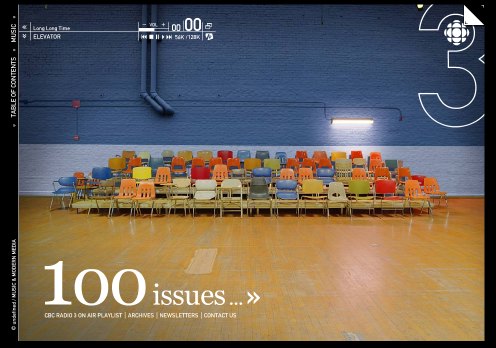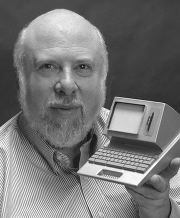In an iMatter meeting we were talking about poster sessions both online and f2f for sharing information. The Visible Knowledge Project has a nice example of virtual posters about learning and technology. These posters were created with a snapshot tool based on the Knowledge Media Laboratory KEEP tool. (See What is KEEP? for an overview.) KEEP encourages instructors to gather snapshots of their teaching experiments so that they can be shared easily as virtual posters. The underlying idea is that we need practices that let us share scholarship of teaching quickly.
Continue reading Teaching Knowledge Posters
The Passing of the CBC Radio Three Web Magazine

One of the best designed web magazines, the CBCRadio3.com Magazine site has “published” its last issue. An article in the Globe and Mail by Alexandra Gill, “CBC Radio Three’s lauded Web mag dies” (March 5, 2005, Page R5) nicely points out the irony of CBC killing this award winning radio site just when others are moving in.
I know from my students that the site had the attention of the youth demographic (or at least some of them.) It was an attempt to reach youth in a way that CBC Radio 1 and 2 didn’t. It was a multimedia magazine with music, arts, and essays rather than a radio show. The site lets you listen to music (and control it) as you read the mag – a bit like having the radio you listen to and the magazine you thumb through coordinated. The interface design was brilliant and immediately intriguing, even if difficult to figure out initially.
Why CBC is killing it is not clear. Perhaps not enough people want to watch radio off the screen or perhaps they want to get out of online media and stick to radio. Podcasts will be next.
Statistics Canada Report: High-tech Growth
According to a story by Jack Kapica, “Globetechnology: Canadian high-tech sector shows signs of growth” (Globe and Mail Update, March 4, 2005), Statistics Canada is reporting that the high-tech sector is showing high rates of entry of new businesses which show that financial backers see opportunity. The high rates of entry could lead to strong employment growth. The Statistics Canada report is titled “An anatomy of growth and decline: high-tech industries through the boom and bust years, 1997-2003“. Here is the abstract:
This paper tracks the growth and decline of information and communications technology (ICT) industries that were synonymous with the so-called new economy boom of the late-1990s and its subsequent bust period in the early 2000s. The analysis focuses on the question of whether the ICT bust has been accompanied by a structural shift illustrated by less firm turnover. It shows that to date there is little evidence of a structural shift. Entry rates of new establishments within the ICT sector were above those of other sectors within the economy during both the ICT boom and bust. This is evidence that both firms and entrepreneurs continued to see opportunities to develop new products and markets even during a time of retrenchment. The location of the ICT sector also showed little evidence of a change.
Stanford d.School
The Stanford Institute of Design or d.school is “a bold new design institute at Stanford founded by the likes of Terry Winograd. It seems to have come out of “Computer Science, Mechanical Engineering, Management Science and Engineering, and the Graduate School of Business”. Strangely there don’t seem to be any architects or artists involved – it seems to be about engineering and business.
The web site is brilliant, I love the d.Manifesto – “All you need to know. On a napkin.” The section on “Our Place” also shows their ideas for an innovative project space for students and visiting faculty.
Thanks to Audrey for pointing me to this.
What is a tool?
Language is the principal – or perhaps the only – tool of the philosopher. For Wittgenstein, and for analytic philosophy in general, philosophy consists in clarifying how language can be used. The hope is that when language is used clearly, philosophical problems are found to dissolve. (Analytic philosophy – Wikipedia)
Bernie Frischer asked me what a tool is in the context of humanities computing. Setting aside a discussion of the discourse of tools and ends, here is a first pass:
- An algorithm for the transformation of data. In the case of humanities computing this would typically be for the transformation of linguistic data or strings.
- A utility program that implements an algorithm (see 1.) or simple set of processes in a form that can be used easily. Generally a tool is not a full blown interactive program like a word processor. Thus Excel I would not call a tool as you can use it interactively and you can use it to do many different things. You can, however, run transformations within it.
- A technique that involves transformative or interpretative practices some of which might be automated on the computer. Thus a technique includes both human and automatable practices. Even more generally one can talk about methods that might be made up of various techniques.
- A interactive environment or game in which one can run a set of transformations for a single purpose. See 2. above. There is obviously a grey area between an atomistic tool that does one thing (just what is the doing of “one” thing) and an environment that is multipurpose. At what point does a tool become an environment for processes that isn’t really ONE tool but more a workbench of tools. My point, however, is that we will call an environment a tool if it is used in a context for one end. Thus Excel becomes a tool if I just use it to sort columns of text.
Now back to the real problem which is the presumption that a tool is utilitarian – that is something used not for play, but for achieving a well defined goal.
In Memory of Jef Raskin

Jef Raskin, arguably one of the pioneers of personal computer interfaces, has passed away. See his site, Jef Raskin – Welcome to JefRaskin.com.
For a notice on his passing see, Press Release, February 27, 2005 or TidBITS: In Memoriam: Jef Raskin, 1943-2005.
I became aware of Jef when reading about the Canon Cat (in Byte I think); I was pleased to see that the Canon Cat Manual is on the site.
TAPoR Persona Research
Audrey Carr has a blog now to report on the TAPoR Persona Research she is doing. She is developing a set of personas for the types of people that might use the TAPoR portal from which to develop usability scenarios that we can use in designing the portal.
New Media Highlights
The “Highlights of the Literature Review” of Face of the Future by the Cultural Human Resources Council has a section on the new media industry which has an interesting subsection on definition. One of the key problems with this sector is defining it. Does it include the ICT (Information and Communications Technology), for example? Or is it just the creation, production, and distribution of content?
Continue reading New Media Highlights
New Media Research Centre
The New MEDIA Employment Centre has an extensive list of links on multimedia jobs, employment and industry. A great place to find other stuff.
New Media Competencies
At Mac we use a competencies model to audit our curriculum where we list the things we want students to be competent at when they graduate and then see if these are actually taught and reinforced in the curriculum. I just found a much more thorough list of competencies from the Cultural Human Resources Council. There is a short checklist that would be great for students to check themselves against and then there is a longer disucssion of the competencies in the Profile document. Here is the summary list of professional competencies (which the profile goes into much more detail on):
A. RESEARCH ñ EXPLORE IDEAS
B. IDENTIFY PROJECT OBJECTIVES
C. PROPOSE A PROJECT
D. DESIGN A PROJECT
E. DEVELOP A PROJECT (PRODUCE)
F. MANAGE A PROJECT
G. INTERACT WITH CLIENT
H. PROMOTE PROJECTS OR SERVICES
I. OPERATE TOOLS AND EQUIPMENT
J. SHARE KNOWLEDGE AND INFORMATION
Continue reading New Media Competencies